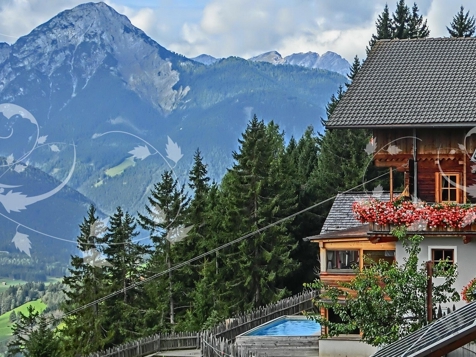Nature Park Three Peaks
Three Peaks and the Sexten sundial, Dreischusterspitze and Paternkofel: These and other impressive peaks are shaping the landscape of Nature Park Three Peaks, which is part of the UNESCO World Heritage Dolomites.
Nature park around the famous Three Peaks
The eponymous Three Peaks are, along with Schlern, the most popular symbolic peaks of South Tyrol and of course just as the Sexten sundial (with Neuner, Zehner/Sextner Rotwand, Elfer, Zwölfer and Einser) a place of longing for climbers. But Nature Park Three Peaks has a lot more to offer.
Surrounded by a unique mountain landscape, the Three Peaks are located in the heart of the homonymous Nature Park. They are more than 200 million years old and the border of the provinces South Tyrol and Belluno today implying “ownership rights” on both sides. The north faces, where history was made from the very start of alpinism, is located on the South Tyrolean side.
Impressive peaks & flowering meadows

The Sundial of Sexten is one of the landmarks of Sexten.
Internet Consulting - Benedikt Trojer
Mt. Dreischusterspitze is an impressive peak in the middle of two side valleys of Sexten, Innerfeldtal and Fischleintal.
Internet Consulting - Benedikt Trojer
View from Lake Dürrensee in Höhlensteintal Valley to the Cristallo Group
Tourismusverein Toblach - Strobl JosefThe nature reserve covers an area of 11,891 ha and parts of the municipal areas of Sexten, Innichen and Toblach. In addition to impressive rock formations, nature lovers are offered wonderful larch meadows in the valleys of Fischleintal or Innerfeldtal, offering wonderful flowers in spring. Not very far from them, Lake Dürrensee in Höhlensteintal Valley is a wonderful viewpoint to the impressive Three Peaks.
Open-air museums
During the First World War, the frontline ran across the Dolomites. The soldiers had to create paths and fortifications and live in the mountains under the most inhospitable conditions. The Alpinisteig path dates back to this time. The project Bellum Aquilarum offers guided tours through the outdoor museum Rotwand and barrier Mitterberg and organizes exhibitions on the theme. Also, when hiking to Monte Piana, you will get interesting insights into the mountain war in the Dolomites.
Hikes to the Three Peaks
All trails lead to the Three Peaks! In fact, there are several possibilities to reach these impressive rock formations. The shortest variant leads along Auronzo hut, that can be reached via a toll road. From there, hikers continue on foot on an easy hiking trail.
The access via Rienztal Valley starting near Schluderbach is a bit longer. Another longer, but scenically impressive hike starts in Fischleintal Valley in Sexten.
Truly the beset view of the north faces of the Three Peaks is from Mt. Paternkofel. The ascent to this neighbouring peak goes through tunnels and galleries built during World War I as well as via a short fixed-rope route. Looking through holes in the galleries and from the peak, the Three Peaks can be seen in all their beauty. Even from the valley, you can catch a glimpse of the mighty rock giants, at the “Three Peaks viewpoint” in Landro in Höhlensteintal Valley.
Famous summit destination
The Three Peaks rise on loose scree slopes. The Große Zinne (“big peak”) in the middle is 2,999 m high, the Westliche Zinne (“western peak”) 2,973 m and the Kleine Zinne (“small peak”) 2,857 m. Simple hikers and nature lovers frequently just watch the Three Peaks from below. Alpinists love to climb them ever since.
The first ascent of the Große Zinne was made by Paul Grohmann, Franz Innerkofler and Peter Salcher in 1869 via the normal route. Emilio Comici succeeded in the first climb of the north face in 1933. In 2008, Thomas Huber climbed all three north faces within 24 hours.
Until today, these three summits are some of the most wanted destinations in the Dolomites and the north faces continue to be a real challenge for expert climbers. Countless climbing routes with different degrees of difficulty lead to the summits – from the normal route on the south side, to the Direttissima and the steep, overhanging north faces.
Experiences in nature for kids & adults
The nature park house is located in the Culture Centre Grand Hotel Toblach and houses a permanent exhibition about the UNESCO World Heritage Site Dolomites and about the special features of the Hochpustertal Dolomites. Right behind the nature park house, there is the interpretive nature trail Toblach with 3 stations: the WaldWunderWelt, the tree village Toblach and the Celtic Tree Horoscope. Moreover, the circular trail LandArt allows you to see wonderful artworks. The second nature experience trail with 11 stations around Lake Toblach is as well a highlight for the whole family, offering beautiful viewpoints for birdwatching. The path leads to two nature parks at the same time, as the Lake is part of Nature Park Fanes-Sennes-Prags.
Nature Park House Three Peaks
Culture Centre Grand Hotel Toblach
Phone: +39 0474 973017
E-mail: info.dz@provinz.bz.it






























